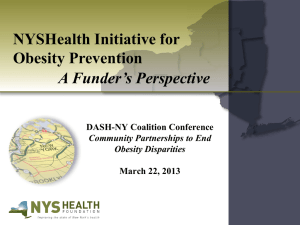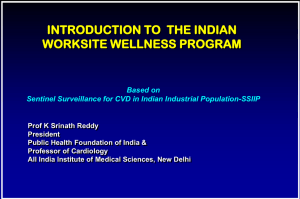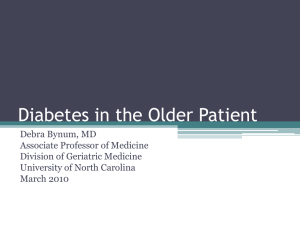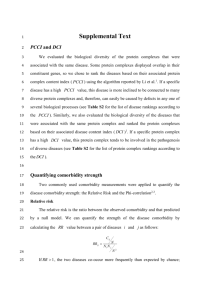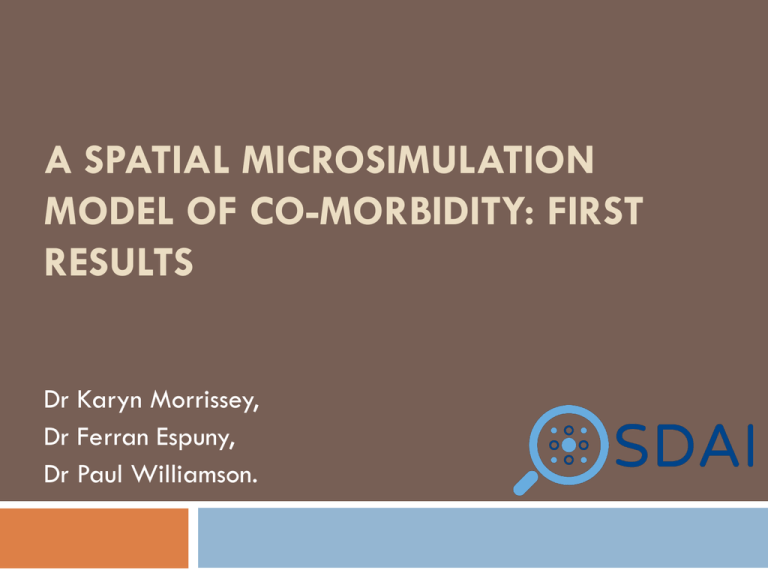
A SPATIAL MICROSIMULATION
MODEL OF CO-MORBIDITY: FIRST
RESULTS
Dr Karyn Morrissey,
Dr Ferran Espuny,
Dr Paul Williamson.
Project Overview & Goals
Develop a model of co-morbidity between CVD, diabetes &
obesity at a small area level for England
Identify the underlying determinants of co-morbidity for CVD,
diabetes & obesity at both the national and health authority region
in England using the HSE
Using spatial microsimulation, develop baseline small-area
population estimates of co-morbidity outcomes for England
Validate the baseline estimates of health service utilisation
associated with those co-morbidities using administrative data
supplied by East Kent Health Trust
Inform health policy, using East Kent as a case study area
identifying areas of apparent under/over-utilisation
Non-communicable Diseases (NCD)
In developed countries cardiovascular disease (CVD), diabetes and
obesity are major contributors to the overall burden of chronic
disease.
In 2010, 48% of NCD deaths were caused by CVD, while diabetes
was directly responsible for 3.5% of NCD deaths (World Health
Statistics, 2012).
Whilst; Approximately 1.5 billion of the global adult population are
overweight (WHO, 2011) .
Along with an increased prevalence of CVD, diabetes and obesity
as single morbidities
Growing body of evidence that individuals are increasingly at risk of
two or more of these diseases
Research on comorbidity
Responding to increased rates of comorbidity and the knowledge
that comorbidity significantly increases mortality rates and
decreases functional status and quality of life, the study of
comorbidity, has increased over the last decade:
Clinician led; focused on:
Identifying the most prevalent groupings of illnesses that
demonstrate comorbidity, particularly among the elderly population
CVD: 2 of the major risk factors are obesity and diabetes
Close link between obesity and diabetes is well established
CVD is listed as the cause of death for 65% of persons with
diabetes
Based on revealed preference; hospital admissions data
Standardised at best by age and sex
Such a focus…
Ignores the accepted empirical evidence that an individual’s health
is the outcome of multifaceted processes rather than age or initial
health status alone (Morrissey et al., 2013).
Ill-health is not only a product of aging, but instead individual level
circumstances.
Thus, this project assumes that similar to single morbidities,
comorbidity is the result of complex interrelationships between
differing health conditions and shared
Demographic,
Socioeconomic and;
Environmental risk factors
Goal 1 – Outcome Multinomial Logistic Model
Identify the underlying determinants of co-morbidity for CVD,
diabetes & obesity in England using the Health Survey of
England
Gender and Marital Status significant, but not as influential as
other variables (standardising by age and sex is therefore not
sufficient)
Black population presents a high diabetes (and diabetes-related
co-morbidity) risk
Asian population presents a high diabetes risk but low obesity
(BMI threshold debate)
Lowest disease risk for individuals with a high income, owning
their own home, in-work and having a degree
Obesity (and related) higher risk for ex-regular smokers but
lower risk for smokers
All of these factors are differentiated across different spaces
And the HSE has very coarse spatial scales: SHA
Goal 2 – Including Geography
Develop baseline small-area population estimates of comorbidity outcomes for England using:
Spatial microsimulation
Combine data from:
Health Survey for England (HSE 2008-2011): Social Health
Authority (SHA) spatial scale
Census of Population (CoP 2011, recent release):
Target Geography – Lower Super Output Area level
(LSOA)
Project Innovation #1
Issue # 1: accessing data at different geographical scales
Both CASWEB and INFUSE are ‘point-and-click’ interfaces aimed
primarily at the novice user.
Neither offers the ability to save complex extraction queries
spanning multiple geographies, tables and cells for re-running or
amendment.
This severely impairs their utility for researchers.
Infuser
We developed a prototype in R software for
Downloading/creating a geography lookup for England area levels
Searching census tables by contents
Getting the census counts at OA level
Obtaining LSOA statistics by aggregation of the OA counts
Received an additional £15,000 + £48,000 from the UKDS
Innovation fund to finalise Infuser
Project Innovation #2
Issue # 2: Wish to use simulated annealing – historically very
slow process (SMILE; 3 months)
Trialling a Combinatorial Optimization method
Global Optimisation (Espuny et al., 2014)
Speeds up current computational process
Allows us to test the effectiveness of potential matching
constraints
a prior at different area levels
validate the effectiveness of using regression models to
choose matching constraints
chose the most effective matching constraints relative to
our simulated variable of interest
Project Innovation #3
Issue # 3: Calibration
(Morrissey et al., 2013) used an external validation method: calibration
through alignment
A hierarchical internal validation process will be conducted to ensure that the
distribution of the single morbidity variables, CVD, Diabetes and Obesity are
consistent across different levels of spatial aggregation
Calibration Data:
The national Quality and Outcomes Framework (QOF) was introduced as
part of the new General Medical Services (GMS).
Participation by practices in the QOF is voluntary, though participation rates
Data related to our comorbidity research are, for each practice centre: the
size of the list of patients, the Coronary Heart Disease Register, the
Diabetes Mellitus (Diabetes) Register (ages 17+), the Obesity Register
(ages 16+)
Pre calibration Results…
Non-Integer (Counts themselves should not change
between integer and non integer)
Matching Constraints & Internal Validation
AvgSAE
AvgRMSE
AvgZ2rel
MaxSAE
MaxRMSE
MaxZ2rel
RatZ2rel<0
Origin by
Tenure
Tenure
0
0.35
-0.93
0.07
26.94
11.08
0.99
0
0
-1
0.01
3.16
-0.53
1
Marital by Sex
by Age
Sex by Age
0
0.07
-0.99
0.04
5.25
-0.17
1
0
0.13
-1
0.02
6.75
-0.47
1
Marital by
WorkStatus
Qualification
0
0
-1
0
0
-1
1
0
0
-1
0
0
-1
1
HRP Origin by
Tenure by Age
HRP
WorkStatus by
Tenure by Age
Sex by Age by
Health
LT1 by Sex by
Age
LT2 by Sex by
Age
Q-IMD
0
0.09
-0.99
0.03
3.02
-0.41
1
0
0.03
-1
0.03
2.94
0.34
1
0.39
20.16
23.07
0.75
76.61
239.92
0
0.87
56.52
58.59
1.66
194.39
1698.43
0
0.88
59.86
70.05
1.67
198.73
1825.98
0
1.51
589.04
162869.52
1.95
1186.76
636108.61
0
The validation measures show a good (but not perfect) fit to the tables used
as constraints and a poor fit to the non-used tables:
Simulation Results
Initial Validation
(Pre-calibration)
Used Self Report
General Health as
a variable for
calibration at the
MSOA Level
Good match!
Overview for England
One Plus Disease
Two Plus Disease
Next Steps
Continue testing the algorithm
Validating the disease estimates using the NHS practice
level data
Complete Project!
Acknowledgements
East Kent Hospital Trust our case partner
The ESRC Secondary Data Analysis Initiative for
funding this research.






